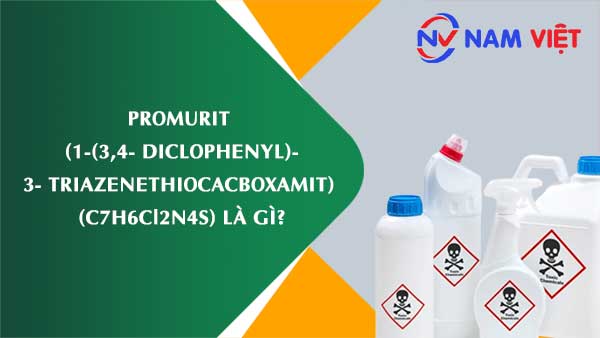Working environment factors
How does Promurit (1-(3,4-dichlorophenyl)-3-triazenethiocarbamoyl) affect workers’ health?
Promurit (C7H6Cl2N4S) is an important chemical in industry, but could it pose health risks to workers? This article reveals the potential impacts of Promurit in factory environments and effective ways to protect health.
1. What is Promurit (1-(3,4-dichlorophenyl)-3-triazenethiocarboxamide)?
Promurit (1-(3,4-dichlorophenyl)-3-triazenethiocarboxamide) is a chemical compound with the molecular formula C7H6Cl2N4S. It belongs to the triazen group containing the thiocarboxamide functional group, primarily synthesized and used in the industrial sector, especially in the production of specialized chemical products.
Structurally, the Promurit molecule consists of an aromatic ring with two chlorine atoms (Cl) at positions 3 and 4, connected to a triazen group (-N=N-NH-) and a thiocarboxamide group (-CSNH2).
This unique combination of functional groups gives Promurit its distinctive chemical and physical properties, while also posing certain health risks if not strictly controlled during production and use.
| No. | Chemical Name (Vietnamese) | Chemical Name (English) | HS Code | CAS Number | Chemical Formula |
| 1. | Promurit (1-(3,4-diclophenyl)-3-triazenethiocacboxamit) | Promurit (1-(3,4-dichlorophenyl)-3-triazenethiocarboxamide) | 29309090 | 5836-73-7 | C7H6Cl2N4S |
See also our service: Chemical Safety Training under Decree 113/2017/ND-CP
REGISTER FOR CHEMICAL SAFETY TRAINING UNDER DECREE 113
2. Sources of Promurit (1-(3,4-dichlorophenyl)-3-triazenethiocarboxamide) in Production
In industrial production, this compound usually originates from organic synthesis processes, particularly in the manufacturing of pesticides, dyes, or some high-tech chemical products. It is formed through chemical reactions between chlorinated aromatic derivatives and compounds containing triazen or thiocarboxamide groups.
Additionally, in some intermediate processing steps, by-products of complex synthesis processes may contain small amounts of Promurit. These sources are mainly found in mixing areas, reaction vessels, distillation units, or during equipment cleaning and industrial waste handling.

3. Industries Using Promurit (1-(3,4-dichlorophenyl)-3-triazenethiocarboxamide)
This compound is primarily used in certain specialized chemical industries.
In the pesticide manufacturing sector, it serves as an intermediate for synthesizing active ingredients for insecticides or fungicides.
The dye and pigment industry uses it to produce special dyes with high stability and good color adherence.
Additionally, in the field of advanced materials, especially for producing heat-resistant or chemical-resistant materials, Promurit is used to enhance product performance, increasing durability and resistance in harsh environments.
4. Health Effects of Promurit (1-(3,4-dichlorophenyl)-3-triazenethiocarboxamide) on Workers
Exposure to this compound in the workplace can cause multiple negative health effects.
Respiratory exposure: inhalation of dust or fumes may irritate the nasal passages, throat, and lungs, causing coughing, breathing difficulties, or respiratory inflammation.
Skin contact: may cause irritation, redness, itching, and, in prolonged or high-concentration exposure, contact dermatitis.
Ingestion: accidental swallowing of contaminated substances may result in digestive problems such as abdominal pain, nausea, and diarrhea.
Long-term low-level exposure may pose risks to liver and kidney function and potentially affect the central nervous system.
5. Safe Exposure Levels for Promurit (1-(3,4-dichlorophenyl)-3-triazenethiocarboxamide)
Currently, there is no specific information on safe exposure levels for Promurit under Vietnamese law. Safety levels should refer to international standards and best practices in the industry. 
At a basic level, in industrial environments, complying with safety standards and minimizing exposure to Promurit (1-(3,4-dichlorophenyl)-3-triazenethiocarboxamide) is crucial. Organizations like the U.S. Occupational Safety and Health Administration (OSHA) provide guidance and safety principles to protect workers from harmful chemical effects.
6. Measures to Minimize Health Risks of Promurit (1-(3,4-dichlorophenyl)-3-triazenethiocarboxamide)
To reduce the impact of this compound on worker health, technical controls should be implemented such as local exhaust ventilation, using specialized air filters in areas with chemical fumes, and conducting production in closed systems to limit chemical dispersion.
Workers should be equipped with personal protective equipment including respirators, chemical-resistant gloves, protective clothing, and safety goggles.
Regular training and chemical safety education must be conducted to ensure workers understand handling procedures and emergency responses.
Additionally, periodic health monitoring is necessary to detect early signs of exposure and implement appropriate interventions.
Occupational Safety Training: Workers should receive ongoing education on risks and safety measures when working with this chemical.
Regular workplace environmental monitoring should be conducted to assess harmful factors and adjust to prevent occupational diseases.
7. Nationwide Workplace Environmental Monitoring Center
Nam Viet Workplace Environmental Monitoring Center is a professional unit for supervising and measuring labor environment quality throughout Vietnam. Experienced monitoring specialists and modern measuring equipment ensure accuracy and reliability.
REGISTER FOR WORKPLACE ENVIRONMENT MONITORING SERVICE
In addition to monitoring services, the center assists clients in planning, handling, and following up on labor environment issues. With a customer-centric approach, it ensures satisfaction and delivers the best solutions for businesses.
Nam Viet’s investment in technology and skilled staff has made it a trusted workplace monitoring unit in Ho Chi Minh City, with goals including:
- Maintaining brand reputation and service quality.
- Providing clients with the best and most suitable solutions.
- Leveraging a team of experienced Masters and Engineers committed to environmental protection and business benefit.

- Clients working with Nam Viet receive professional service from industry experts and the best cost advantages.
8. Pricing for Workplace Environmental Monitoring
To help businesses perform professional and effective workplace environmental monitoring, Nam Viet provides clients with a detailed pricing table for monitoring services.
- Our pricing table provides detailed costs of monitoring services, including travel, measurement, analysis, and reporting. Clients can trust the accuracy and reliability of the results.
- We ensure competitive and reasonable pricing and are always ready to consult and answer inquiries promptly and professionally.
- With Nam Viet’s pricing, clients can easily select suitable service packages and are guaranteed satisfaction with professional service quality.

